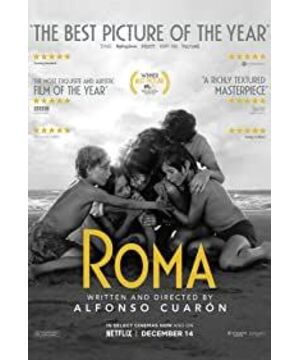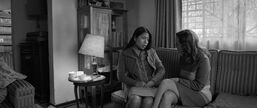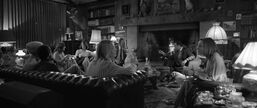This is a great movie. This is a movie that a person wants to applaud several times when watching alone on a small screen. This is a movie worth enjoying and experiencing again on the big screen in the cinema. It is worthy of being the highest-scoring work of Metacritic of the year. If I watch the time many times while watching a movie, I must be looking forward to the end of the film quickly, but this time, I am looking forward to the end of the film. You go on quietly, and I quietly continue to watch.
Just when I was walking last night, I wanted to understand a question: My interest in Japanese culture is actually not in Japanese culture itself. Either I am contemplating Chinese culture by understanding it, such as comparing the dilemma of modernization from history and reality; or I like the combination of it with Western culture, such as Kurosawa Akira's movies and Fujita's paintings, the essence Shangdu is deeply infiltrated by Western culture. As for those cultures that are really Japanese, I don't feel it, or even disgust it.
Therefore, if Japan and North America both have such narratively plain movies with their own cultural attributes, then I will be closer to the latter than the former, such as "Manchester by the Sea" which I extremely love. This year's "The Thief Family" won the Palme d'Or and the film that won the Golden Lion Award is just such a contrast. The former is "a movie that is very well shot but can’t hit me in any aspect", and the long symmetrical and still shot of the film caught my heart from the first act of the opening (I didn’t pay attention to the book before I haven’t seen any information about the film, even the trailer, I don’t even know that it is a black and white film, there is no expectation). The above differences are largely personal aesthetic preferences, and I believe that many viewers will feel completely opposite to mine.
The film's title originated from a community called Rome in Mexico City and has nothing to do with Rome in Italy. In fact, the director himself grew up here, and the address of his home was even directly given in the movie: 21 Tepeji Street. However, in order to make better use of natural light, the real framing was carried out at No. 22 across the road (but the house number was changed to 21, which can be seen in the scene when the male protagonist is driving away). This is a belt There are Art Deco-style houses, as can be seen from the patterns of doors, windows and stair railings, it is clear that the owner’s house belongs to the upper middle class. And the subtitles used in this film is also an Art Deco style font (specifically, it should be a variant of the Gloria font), which is the font style commonly used in Hollywood movie posters in the 1930s and 1940s, with A distinctive brand of the times.
The story of the film is very polished. The maid’s unmarried first pregnancy and the hostess’s family crisis constitute two main lines respectively. At the micro level, the interaction between the servant and the host family has become the glue between the two main lines; at the macro level, the maid’s perspective intentionally or unintentionally reflects the background of the era of class separation, urban-rural differences, social changes, and political protests. On the way the maid went to the countryside to find a scumbag boyfriend, the distant scene "inadvertently" showed politicians doing propaganda to the masses and performing juggling of cannon shooting at living people. If Jia Zhangke used this idea to deal with the street performances of the Caotai team in "The Children of the Rivers and Lakes", the flavor might be better. Note that the director positioned this film as his childhood memory. It is impossible for a ten-year-old child to have a deep understanding of the social and political complexities (it is also impossible for a maid who is inexperienced in the world), so he Without deliberately focusing on the macro level of the film, it is like not feeling the madness of the Cultural Revolution in Jiang Wen's "Sunny Day".
The film contains a lot of intentional and interesting details in the narrative. For example, the dog that can never leave the house and its shit that often appears, the car that is difficult to drive into the house every time, and children wearing astronaut helmets appeared in the forest and on the muddy roads in the countryside (representing the director's own childhood) , The wine glass broken by the maid on New Year’s Eve, and the gods in the forest fire chant the arrival of the new year. When the political protest turned into a conflict, the person who was shot to death in the furniture store echoed the scene of a child who was shot to death on the side of the road shortly after the opening, and the maid who was about to give birth was beaten on the side of the road. The dead men are in contrast. Suddenly, such a dramatic conflict of life and death occurred after most of the dull process, which was particularly capable of hitting the hearts of the audience. Finally, after the furniture was moved, there were scattered books in the room, which made me realize that the heroine has enough books, which also coincided with her choice of going to the publishing house as an editor. The heroine is "hidden" like these books, and the audience didn't know that she was a chemist until the end of the book. By the way, the living room on the second floor for watching TV has completely changed its orientation, heralding a new life.
Due to the wrong schedule, the director personally took the shot in the end, making the use of the lens language and the text content complement each other more and more. There are mainly three lens languages used in the movie: first, there are a large number of fixed lenses, and the audience seems to be admiring a painting of naturalism or realism; then there are repeated panning shots, and the audience follows the eyes of the camera to look at this. At home and even in the world, the scene where the maid turns off the lights uses a 360-degree pan, which is extremely comfortable to look at. Finally, there are multiple panning (tracking) shots that specifically aim at the maid’s outdoor activities. The audience also followed the Mexico City social customs in the 1970s, and glimpsed the leisure time of the soldiers when the political protests took place. In addition, the two vertical shots at the beginning and the end are received from the ground to the sky, and the plane flies and flies away, forming an intertextuality (obviously, the washing water at the opening and the waves at the high tide are also intertextual).
The film's choice of black and white is unique. The black and white itself has a sense of age, but the director specifically chose high-definition digital photography instead of deliberately diminishing the rough texture of the film. This kind of high-definition does not bring the unreality of viewing the movie, but because the picture contains many details, it feels immersively real. I think the director chose black and white to give the film a restrained and gentle tone, just like the gray-blue color throughout "Manchester by the Sea". The colorful Mexican culture is incompatible with this tone, including the sun, beaches, green spaces that appear in the film many times, and the children’s rooms must also be filled with colors, so black and white is the best way to reconcile these colors. The choice is also in line with the characteristics of memories.
I chose black and white, so I pursue excellence in image effects. From the perspective of the director's intention, this meticulous sense of refinement is the childhood in his memory. From the perspective of audience needs, the loss of color means the loss of a lot of picture information, which needs to be compensated by composition, mirror movement, lighting, props, etc., including the choice of 2.35:1 wide format, so that the audience can receive from the picture To get more information and willing to actively participate in the picture. The reason why every ordinary picture and every shot of everyday life can bring the audience a pleasing look and feel is that there are actually a lot of elaborate designs behind it, and these are usually not realized by the audience. In addition, if the scene of the birth of a dead baby was not black and white, it would probably cause extreme discomfort. Or conversely, the director used the psychological characteristics of black and white films to choose to let the audience face dead babies.
Finally, I quote Ang Lee’s consistent view: If you feel that the taste of a movie is right, then everything is right. (Conversely, a movie with wrong taste must have something wrong with some aspects or even many aspects.) To me, taste is closed, and it is a work that is all right. So far, "Manchester by the Sea", "Books: New York Public Library" and "Rome" have become my favorites for three consecutive years. Congratulations in advance that this film will become the first best film to win the Oscar. Foreign language films.
View more about Roma reviews











